Ok, firstly I have to admit I make this in a bread machine…if that makes me wrong then I don’t wanna be right, baby! Yes, I like making bread from scratch and the visceral feel of it is luscious and the getting down and dirty with the ingredients is compelling but…I’ve got heaps of books lying around unread…so it’s all about priorities. A friend makes a sourdough loaf (which is lovely) born from a jar rescued from an episode of Quatermass, which takes ALL DAY to wrangle. Lord have mercy…and say no more…
Second point about this bread is that it is something I made for myself initially without thought to recipe posting but only thinking of my diet. It’s a splendid mix of complex slow release carbohydrates with proteins and micro nutrients that make it almost a dietary sin NOT to eat!
Incidentally, as always and ever, I use the word ‘diet’ as in food intake (literally ‘the diet’) rather than those ridiculous Tenko style regimes of eating that only fools put themselves through in vain efforts to lose weight. Diets don’t work!! It’s an eating life style change that is needed…and breathe…(someone burn this soapbox please, I’m boring myself….)
So it goes something like this (I know people bang on about the exact science of baking but I have made this loaf a hundred times and each time with some variation and fluctuation in amounts for various reasons (usually because I’m too busy talking…) and it’s ALWAYS turned out gorgeously):
340ml of warm water (what with my eye sight and the ancient plastic jug I measure with this is an average figure!)
500g of wholegrain spelt flour (I suspect other whole grain flours work but there’s a gluten content fluctuation wrangle which I simply cannot get into here – anyway the steely eyed silver fox Mr Hollywood has covered this a zillion times)
1 and a half teaspoons of fast acting yeast
2 tablespoons of cold pressed extra virgin olive oil (cos that’s what I have – other olive oils will work too – avocado is a good option)
Handful of mixed seeds – I use pumpkin, sunflower, linseed (flaxseeds) and sesame seeds because that’s what comes in the packet I buy! Also, I know ‘handful’ isn’t very useful but I never measure it and it’s a question of taste too. I s’pose it’s anywhere between 50 – 100gs
Optional – 75g of mature organic cheddar – or just break a chunk off and grate it in like I do…don’t judge me! I like a more ‘savoury’ bread so this completes that taste spectrum but just leave it out if you don’t fancy it. Please yourself. Please.
I don’t add any salt and I add the ingredients to the machine in the order above. I then set the machine to rapid bake (shortest baking time setting) and press start.
It’s arduous I must say…I am completely knackered after all that effort and need to sit down and read my book for an hour…well, for 58 minutes actually cos after that it’s done!
Now my machine produces the most wondrous loaves, perfectly cooked and browned on all sides and the bottom…but not the top. Dunno why and I suspect there’s a knack but I’ve got into the habit of chucking it under the grill for a few minutes to sort it out that way. Bit Heath Robinson I’m sure but nonetheless delicious. Actually…I only did this once and completely for show. Now I can’t be arsed so I just eat it with it’s paler top. Tastes the same after all…
Obviously, due to the lack of anything resembling a preservative this loaf will not keep for very long. Depending on how many people and how much bread you eat etc. it will keep for a few days in an airtight container but get crumblier and probably be in need of a toasting to rejuvenate it! To avoid this I slice it when it is cool and freeze it to use whenever desired (I place pieces of foil between the slices to prevent them sticking together and me having to launch them at the counter top in an attempt to free a single slice…the voice of experience!) It toasts beautifully from the freezer in a toaster and provides an anytime chance for a healthy snack.
If you are not making this in a bread machine then be aware that the gluten in spelt is much more delicate than it’s modern cousin wheat and needs more careful handling. Halve both the kneading and the proving times than those of wheat, especially the latter because if the loaf goes too far during the proving process it will collapse and ruin. The more fragile nature of the gluten in spelt also means it is easier to digest and often those who are wheat intolerant can manage it.
Spelt has a far broader range of nutrients (especially minerals) than it’s modern day relatives and the wholegrain element of it is the clincher. I cannot say this often enough but fibre is an utterly vital part of your dietary intake, yet it has to be the most overlooked.
Seeds are a gift from nature to our health. Portable and easy to fling into just about anything, they pack a substantial nutritional punch for their size! Their speciality is minerals and these elements of our body’s function are often mysterious I think so I’m listing them here to show, at least, how intrinsic they are to our survival.
Pumpkin seeds are noted for their high mineral content, especially zinc (used throughout the body to maintain efficient flow of all processes, boosts immune and nervous system function, used to metabolise carbohydrates and protein, maintains the prostate, helps the formation of insulin and collagen, used in the contraction of muscles) and manganese (helps metabolise fats and proteins to create energy, used in the forming of healthy bones, tissues, nerves and cartilage and for a healthy reproductive system). The seeds have vitamin E (proper functioning of the reproductive and immune systems, prolongs the life of the red blood cells, maintains nerves and muscles, helps metabolise polyunsaturated fatty acids, powerful antioxidant value (especially fats in cells), anticoagulant – said to reduce the risk of heart disease, reduces blood pressure and promotes healthy hair and skin) but also versions of vitamin E that are also a key part of the complex antioxidant processes within the body, providing the body with a better antioxidant platform than just regular vitamin E by itself.
Sesame seeds are noted for their mineral content too. They are high in copper (used to make red and white blood cells, vital for infant growth and brain development, assists immune system (and helps defend against infection), used for strong bones and blood vessels, protects nerve tissue and as an antioxidant it mops up and deactivates free radicals), magnesium (part of the strong bones and teeth triad of minerals and helps build body tissue, used in the muscles to create contractions, assists nerve function, used to activate metabolism and energy production, used in enzyme activation for regeneration, said to be useful against PMS as it combines with calcium to form a natural muscle relaxer) and calcium (essential for strong bones and teeth, used in nerve and muscle function and signalling, used in the muscles for contraction (including heartbeat), blood clotting, said to lower risk of colon cancer, regulates fluid balance) but also contain iron (needed for making haemoglobin (in red blood cells) that transport oxygen/carbon dioxide to and from cells, used in growth, energy production and metabolising B vitamins, helps fight fatigue and resist disease through assisting the immune system, assists the body remove unwanted substances) and phosphorous (used in all the chemical and metabolic processes of the cells and their structure, works with calcium to grow and maintain strong bones and teeth, involved in regulating the heart, kidney function and nerve impulses, helps maintain the HP balance of blood).
Sunflower seeds are high in polyunsaturated fats (Omega-3 and Omega-6 the two essential fatty acids the body needs yet cannot make), the antioxidant vitamin E (also cardiovascular benefits and anti-inflammatory effect on the body’s systems) and the minerals magnesium and selenium (powerful antioxidant (working with vitamin E) mopping up free radicals, used in proper functioning of the immune system, reduces inflammation, used in male reproductive system).
Linseeds (flaxseeds) are noted for their Omega-3 content. Of the two essential fatty acids Omega-3 is the harder one to get into our dietary intake and flaxseeds are a brilliant way of doing this. Incidentally, the ground up version is widely available in supermarkets now and can be flung in just about everything, which is especially useful if you’re not a fan of the other great way to get this essential fat – oily fish! Omega-3 is vital for reducing the inflammation throughout your body, keeping cells lubricated, key part of the regulation of fat storage and release, inhibits the thickening of arteries and is thought to battle the growth of cancers. It also becomes a gum like fibre when ‘processed’ and slows the digestion of foods to allow for the proper ingestion of nutrients.

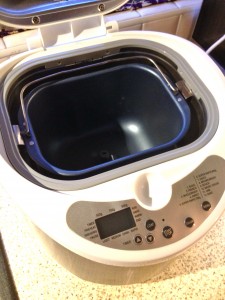
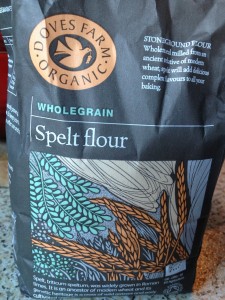
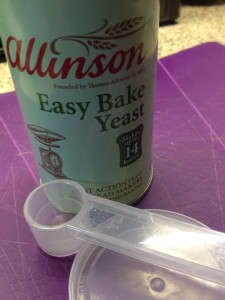
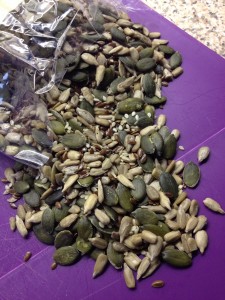
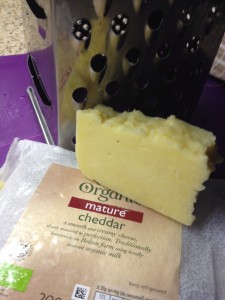
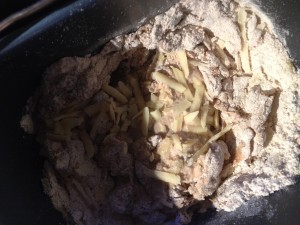
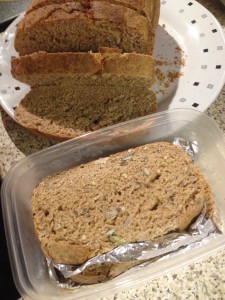
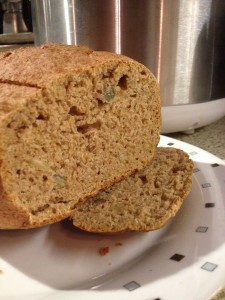
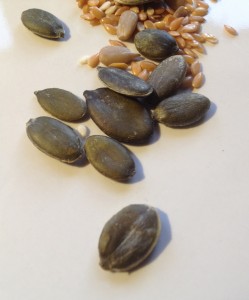
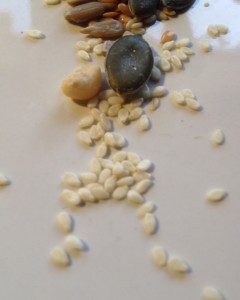
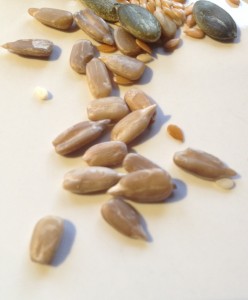
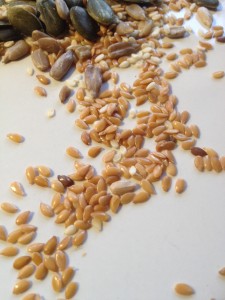
I love making my own food too – I like to know what’s gone in it. I have a lovely olive loaf recipe, although I am going to give your cheesy loaf a try now. It sounds gorgeous!
Great! Let me know how it goes and any improvements you discover!
Hurrah! I’m about to try my first spelt loaf. How exciting, thanks for all these tips. xx